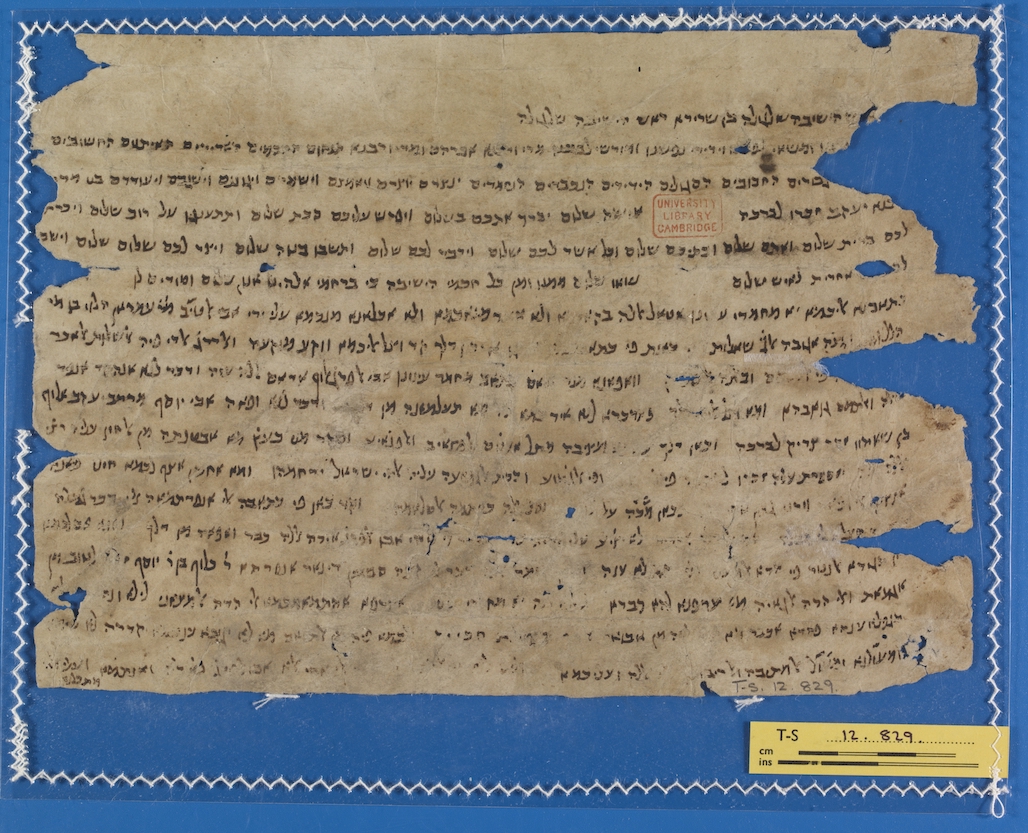Throwback Thursday: Study of Babylonian Jewry

Our Throwback Thursday this week is taken from issue 21 of the printed edition of Genizah Fragments, published in April 1991, by Moshe Gil, Professor of Jewish History at Tel Aviv University:
In 1968, I started my research on the history of the Jews in Muslim lands in the early mediaeval period (frequently called the “geonic period”) with my late teacher, Professor S. D. Goitein. Since then, the main source of documentation for my work has been the Cairo Genizah manuscripts. I have made many visits to Cambridge in order to read the Genizah letters in the original and to utilize the rich book collections of the University Library. I estimate that more than two-thirds of the so-called “documentary” Genizah is to be found in Cambridge. For more than twenty years I have been working on the identification, deciphering and transcription of letters and various documents in the belief that historical research on any topic necessitates a wholesale approach.
Before analysing the documents, one has to collect all possible sources in an exhaustive manner, so as to obtain as complete and accurate a picture as possible. Following this method, I based my studies of heqdesh (community property) on some 170 documents and those of Palestinian history (mainly of the eleventh century) on some 650.
My present project deals with the history of Babylonian Jewry in the early Middle Ages - the first centuries of Muslim rule - and with the position of Jews in the economic life of Muslim lands during that period. A by-product will be a summary of the contemporaneous history of the Jews in Sicily. The project is based largely on a comparative study of data found in the Genizah with other sources.
Although some 100 letters of the Babylonian yeshivot have been published in as many books and articles since the end of the last century, the complete and revised edition I am preparing will result, in many respects, in a better understanding of historical phenomena. Foremost among these are the office of the exilarch, the early origins of Karaism, and the contacts between the yeshivot and various parts of the Diaspora. It is clear that the three yeshivot of Babylon and Palestine were not merely institutions of learning, but functioned as authoritative bodies controlling much of the communal life of the Diaspora.
The 850 merchants’ letters of the eleventh century provide an opportunity to identify and describe the main families and personalities involved in the international trade of the period. They also contain essential data on social, political and military events and the manner in which the Babylonian yeshivot provided communal leadership for the greater part of the Jewish world.
An interesting example is fragment T-S 12.829, a letter in Judaeo-Arabic from Hai Gaon, written in his own hand. Emanating from Baghdad on 19 Adar 1318 of the Seleucid era (9 February 1007), it is addressed to Abraham and Tanhum, the sons of Jacob in the city of Fez in North Africa. The fragment mentions queries sent with a caravan of Muslim pilgrims on their way to Mecca, probably to be left in Egypt for further dispatch. The Gaon deplores the death of Abu Yusuf Jacob (ben Nissim) ibn Shahun of Qayrawan of which he was informed by Abu’l-Faraj Joseph (ibn ‘Awkal) writing to him from Fustat. He expresses his deep sorrow and describes the mourning for the deceased in Baghdad.
The sad news reached him, the Gaon notes, a short time after the demise of his father, Sherira Gaon:
…the quire containing your other queries was sent with the pilgrims’ caravan… A few days ago, a letter reached us, from our beloved aluf abu’l-Faraj, may God grant him everlasting honour, in which he wrote to us about the demise of Abu Yusuf, our Lord and master Jacob aluf ben Shahun, may the memory of this righteous be blessed… This was one of the most distressing disasters and blows that we have suffered… and I eulogised him in our meetings and gatherings, and the community wept over him… This was a sorrow added to the sorrow over the demise of our diadem, the Gaon our father… [lines 8-12].
What happened next? Moshe Gil published a full edition of this fragment in volume 2 of his monumental במלכות ישמעאל בתקופת הגאונים (In the Kingdom of Ishmael in the Geonic Period) (1997). The following year he was awarded the Israel Prize for his contributions to Israeli scholarship. He passed away in January 2014 at the age of 92. Hai Gaon had a similarly long life, passing away at the grand age of 99 in 1038 CE.

Add new comment